
|   |

|   |
Swapnoloker Bideshini - A tribute by Natmandir on Poila Boishakh - Dr.Nita Vidyarthi e-mail: nitavidyarthi@gmail.com Photos courtesy: Anurekha Ghosh June 6, 2023 The joyous occasion of Poila Boishakh, the Bengali New Year, is celebrated in myriad rich and varied ways in the dance and music world but mostly characterised by stereotypes. 'Swapnoloker Bideshini' by Natmandir Kolkata, guided and curated by the erstwhile Birmingham based Kathak dancer Anurekha Ghosh was an imaginative example of a difference in presentation. The enchanting evening of dance, music, narration, recitation, songs and videos, interspersed with a wee bit of dramatic moments, at the Satyajit Ray Auditorium, Rabindranath Tagore Centre, ICCR, Kolkata was not just about ushering in the New Year, but a tribute to Anurekha's mother, who was the inspiration and motive force behind all her creative pursuits. The UK based stylish dancer, now permanently in Kolkata, was trained by Pratap Pawer and Nahid Siddiqui and is a versatile choreographer, dedicated teacher, also trained in Rabindrasangeet by the acclaimed singer Swagatalakshmi Dasgupta (Aakash). The sophisticated program with different performance idioms, bringing together text and movement design had aesthetic appeal featuring the disciples of Anurekha's institution Natmandir, Nrityangan (Mogra) disciples of Anju Bhattacharjee and Debojit Mukherjee, closing with a riveting solo by Guru Durga Arya, prime disciple of Pandit Birju Maharaj including a short Kathak duet with Anurekha. After offering flowers to the photograph of Anurekha's mother, placed at a front corner on the stage, the large screen behind the stage lighted up with a beautiful video shot outdoors, featuring Anurekha, unfolding gently the rich and varied splendour of classical Kathak movements set to her own narration of "Chaitrer khoro taap, jhara pata..." (scorching heat of the Bengali month Chaitra with falling leaves...). The basic feeling entwined with the psyche of the people of Bengal - to get rid of the old and welcome the new on the first month Boishakh of the Bengali calendar with hope and goodness - was showcased in this very first presentation "Naba anandey jago" (wake up to a new bliss) the title being borrowed from the opening line of a Tagore song. The dances for this collage were set to recorded audio support on track. Anurekha's introductory presentation was the initiation on the screen of the first part of "Naba anandey jago".  Anurekha and group The shift from the virtual to the stage presentation comprised of a bouquet of dance presentations set to Tagore's poems and his selection of Brahmasangeet and songs incorporated with bandishes of Hindustani classical music together with a joyous, popular folksy Bengali number. The performance commenced with a lovely group presentation by the senior disciples of Anurekha with the projection of the rising sun on the screen and the refrain of "Jago bhor bhayo" in the distinguished singer Hariharan's voice. The theme of a new beginning and the narration by Anurekha was followed by the immaculately presented title song "Naba anandey jago" by the celebrated Kavita Krishnamurthy. The imagery by dancers with lotuses in their hands entering the stage with neat steady movements, forming designs with swirling lengths of white cloth made for an impressive beginning. The screen was used for projection of photographic stills. A series of dance items followed, set to Rabindrasangeet by distinguished artistes having incredible richness of texture and music, supported by narration and recitation. The captivating Brahmasangeet's "Borisho dhora majhe shantir bari", "Jogotey anando joggye" and the soul-stirring concluding prayer song, "Barsho oi gelo choley" with intense lyrics and plea to the Almighty, was by the distinctive Swagatalakshmi Dasgupta who also recited an English translation of hers from Tagore's original - "The whole world is suffering O Lord" - from her book Galaxy. "I have had my invitation to this world's festival," the English version of "Jogotey anando joggye" from Tagore's Gitanjali had been used as poetry. With her exquisite singing, tonal quality and timbre in her voice the pivotal song "Hey Nutan" acquired a different dimension and appeal. Here, it is necessary to state that this number composed by Tagore for his birthday is generally sung regularly on 'Pochishe Boishakh', Tagore's birth anniversary (25th day of Boishakh, that is 9th May). In this collage, the last two lines, "Pochishe Boishakh Hey Nutan" referring to Tagore's arrival in the world, was omitted purposely for being out of place. But it was added later for another presentation of this item on the day of the Bard's birth anniversary. Sounak Chattopadhyay, a young well-known versatile singer, has acquired a special place in the listener's heart with his own inimitable style of incorporating bandishes and sargams in his renditions of Rabindrasangeet. Hence the weaving in of "Pratham jot jwaley" in the number "Aloye alokmoy korey hey" focussed on the poetic and lyrical dimensions of the song and took the elegant and well-coordinated dance presentation of the disciples of Anju Bhattacharjee to an evocative level. Sung by a group of celebrity singers Lopamudra, Srikanta Acharya, Jayati Chakravarty, Arunasish Roy and Shovan (Saregama champion) the joyous vibrant number "Dakschey Poila Boishakh" with a folksy flavour saw energetic happy dancing giving a harmonious pictorial effect. The choreography offered glimpses of the harvest time rural atmosphere especially while dancing with hand sieves (kulo) and festoons. It was entertainment to the fullest when dancers arranged themselves to form a moving bullock cart! Fairly eloquent with the spirit of the celebration of the New Year and harvest festival, the choreography was neat and the dancers executed it with intense discipline. The production concluded with the solo by Anurekha bidding farewell to the year in the song "Barsho oi gelo choley" (the year passes by). It was a perfect finale for this presentation with a very slow diagonal exit across the stage by a chain of five dancers headed by Anurekha. This idea kept alive the theme of the song offering a fine visual with light effects being a perfect conclusion. However, the preceding poignant atmosphere created by the effect of the pandemic with dancers carrying stretchers, apron clad masked doctors treating the sick, jarred, and did not quite match or highlight the otherwise impressive production. 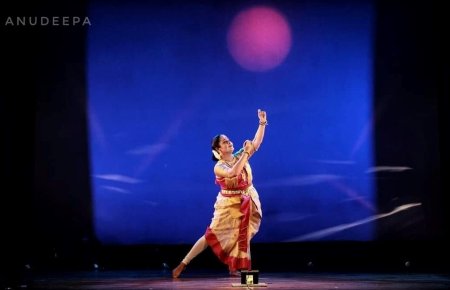 Anurekha Ghosh 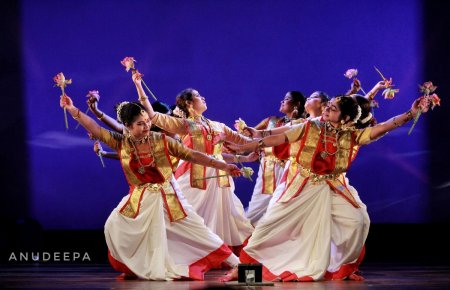 Naba anandey jago The choreography of "Naba anandey jago" was by Anurekha and Debojit embracing different stylised movements - stretched ones, vertical lines, circular ones and diagonals with the basic hastas of classical Indian dance and Rabindrik styles (Rabindra Nritya) often set to Rabindrasangeet and avoided Western performance in gestures, sensations, rhythm and tones. Fascination intensified by witnessing the openness to the fertilised ideas, choreography, good teamwork by the well-trained dancers and appropriate light projection by Uttiya Jana, satisfying the onlookers. Concept, visualisation, creation and narration were by Anurekha Ghosh, cinematography and editing by Rittik Chakraborty and Ashish Kumar Dutta. The Kathak segment with live music was a feast of Kathak dance recitals by students of Natmandir. It commenced with the invocation "Matri bandana" - the worship of Shakti by three dancers set to the mantra "Jayanti Mangala Kali, Bhadrakali Kapalini". This was followed by a number of well-taught nritta items exploring the elements of the dance form in teentaal by learners of different levels. They stood out for their training in rhythm, stamina and confidence specially in tatkaar, ginti, kavit and Saraswati Vandana making their teacher proud. The presentation of the all-time favourite "Sab banthanke ayee Shyampyari re" by three seniors was delightful especially for the elegant choreography and uniformly performed abhinaya. The colour of the costumes deserve special mention. The much awaited "Katha Kaha se Kathak" by the ace dancer Durga Arya began with the invocatory bhajan "Binati suno mori aab Gokul ke Kanhaiya" and "Bhav Nritta" in teentaal, vilambit. The subtle graces of Kathak, so typical of her Guru Pandit Birju Maharaj was brought out with no exhibitionistic aggression right from the beginning in her tatkaar which was spiced with bhav especially with movement of the eyes and eyebrows, adding both richness and quietude. She excelled in khubsurti and nazakat leave alone in an extraordinary layakari and tayyari. With her superlative performance in "Choti choti phatakey" (fireworks) and the tihai in direct and reverse - dusri andaz - Thaat in "alag alag andaz" with bhav with attractive poses, be it coquettish, mood of romance with the play of eyes or "angrai lena"(stretching limbs in laziness), she enthralled the audience. Uthan had some amazing virile footwork and quick flourishes. Anurekha joined in here for a short duet of "Dha taka thunga". Here were some strong dancing, combination of crisp movements and forceful spins. "Bhav ke sath ladi" was a new experience of combination of footwork and form reduced to a perfect definition and more eloquent than description. Her concluding Thumri "Chaita mas bolti koyeliya more anganama ho Rama" mesmerized the audience showing her inimitable skills in abhinaya. 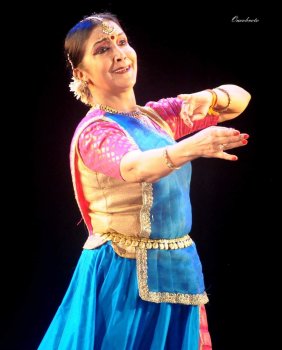 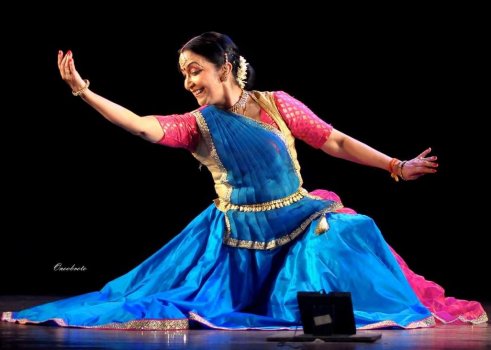
Durga Arya (Photos: Onobroto)
The evening closed with an incredible surprise for the audience at the conclusion of the dance items when the auditorium reverberated with a popular Bengali adhunik (modern) song "Dekhechho ki tarey oi neel nodir dharey" sung mellifluously, flawlessly with perfect diction and articulation by none other than Durga Arya who knows no Bengali till date but learnt, practised and rehearsed to perfection for a month the top chartered Shubhamita Banerjee number which fascinated her! Those who were leaving returned to their seats in the auditorium. Eminent musicians supported the Kathak recitals with Subir Thakur and Kuntal Das (tabla), Sunando Mukherjee (sarod), Arunima Sengupta (Bol Parhant), Sudhakshina Manna Chatterjee and Arindam Bhattacharyya (vocals). Hasi Panchal took care of the sound. 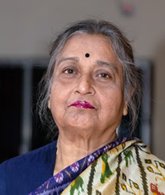 Dr. Nita Vidyarthi is a veteran critic of performing arts and writes on dance, music and theatre in leading publications. |